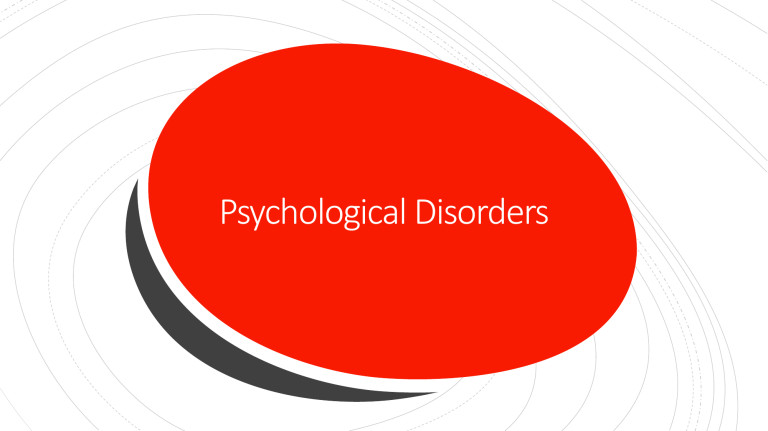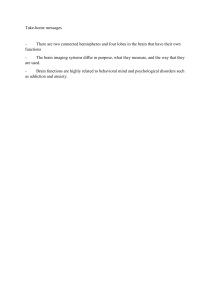
Psychological Disorders Normal & Abnormal ▪Psychological Disorder ▪Syndrome marked by a clinically significant disturbance in an individual’s Cognition, Emotion Regulation, or Behavior (APA 2013) Normal & Abnormal ▪ Abnormal Behavior ▪ Atypical, dysfunction, distressful, deviant ▪ Maladaptive Behavior ▪ Behaviors or actions that run counter to what is in one’s own best interest Typicality & 3 D’s ▪ Typicality ▪ Rarely seen or abnormal ▪ Dysfunction ▪ Interference with daily life and relationships ▪ Distress ▪ Cause an individual to feel uncomfortable or upset ▪ Deviance ▪ Outside the standards of rules of society ▪ Continuum ▪ One end of continuum considered normal, other end may be considered abnormal ▪ Teary farewell v. Profound sadness Normal & Abnormal: Other Factors to Consider ▪ Culture ▪ Uniqueness within different cultures ▪ What is considered normal in one culture may be seen as abnormal in another. ▪ Ex. Koro ( Southeast Asia) ▪ Intense fear that sexual organs will be pulled into the body Insanity Plea ▪ Legal determination of the degree to which a person is responsible for criminal behaviors ▪ Only available in 46 states ▪ Used in approximately 1% of cases ▪ Only 10-25% are successful (Torry & Billick, 2010) ▪ Diagnostic & Statistical Manual of Mental Disorders (DSM) ▪ Currently on 5th Edition Classification of Psychological Disorders ▪ Published by American Psychiatric Association ▪ Evidence-based ▪ Designed to help ensure accurate and consistent diagnoses based on observation of symptoms Classification of Psychological Disorders: Criticisms ▪ Diagnosis may lead to labeling ▪ Stigma from others and self Stigma ▪ Negative attitude or opinion about a group of people based on certain traits or characteristics ▪ May contribute to discrimination, stereotypes ▪ Inaccurate depiction ▪ People-first language to combat stigma David Rosenhan Study ▪ David & 7 others admitted selves to psychiatric hospitals ▪ Faked auditory hallucinations ▪ After admission, began acting normally ▪ Pseudopatients took notes ▪ Seen by staff as part of their disorder ▪ Discharged after they were deemed in “remission” Causes of Psychological Disorders ▪ Medical Model ▪ Psych disorders are illnesses that have underlying biological causes ▪ Psychological Factors ▪ Cognitive, personality factors ▪ Sociocultural Factors ▪ Environment, community resources, poverty, SES Biopsychosocial Perspective Anxiety & ObsessiveCompulsive Disorders Anxiety Disorders Psychological disorders associated with extreme anxiety and/or debilitating irrational fears Anxiety Disorders: Specific Phobias ▪ Distinct fear or anxiety in relation to an object or situation Anxiety Disorders: Panic Disorder ▪ Recurrent, unexpected panic attacks and fear that can cause significant changes in behavior ▪ Panic Attacks ▪ Sudden extreme fear or discomfort, ▪ Often with no obvious trigger ▪ Physical Symptoms: ▪ Increased heart rate, ▪ Sweating, shortness of breath ▪ Chest pain, nausea, ▪ Lightheadedness, ▪ Fear of dying Anxiety Disorders: Agoraphobia ▪ Extreme fear of situations involving public transportation, open spaces, or other public settings ▪ May result in “panic-like symptoms” ▪ May avoid certain settings altogether ▪ May need another person to accompany Anxiety Disorders: Social Anxiety Disorders ▪ Distinct fear of social situations ▪ May stem from preoccupation with offending someone or behaving in one way that reveals anxiety ▪ Fear of judgment and scrutiny of others Anxiety Disorders: Generalized Anxiety Disorder ▪ Excessive worry and anxiety ▪ Regarding activities related to: ▪ Family ▪ Health ▪ School ▪ Aspects of daily life Anxiety Disorders: Obsessive-Compulsive Disorder ▪ Characterized by: ▪ Unwanted thoughts or obsessions ▪ Repetitive, ritualistic behaviors ▪ Obsession ▪ Repeated thought, image, urge that occurs repeatedly ▪ Intrusive and unwelcomed ▪ Causes anxiety and distress ▪ Compulsion ▪ Behavior repeated over and over ▪ In an effort to reduce anxiety ▪ https://www.youtube.com/watch?v=u9VVacspNQU Depressive Disorders Depressive Disorders: Major Depressive Disorders ▪ 1 in 5 people experience MDD once in their lifetime ▪ Includes at least one major depressive episode (some individuals may have recurrent) ▪ Occurs for at least 2 weeks ▪ Causes significant stress or impairment ▪ Not due to medical or drug-related condition Symptoms of Major Depressive Disorder ▪ Depressed mood, which might result in feeling sad or hopeless ▪ Reduced pleasure in activities almost all the time ▪ Substantial loss or gain in weight: without conscious effort, or changes in appetite ▪ Excessive sleep or insomnia ▪ Lethargy ▪ Thoughts or worthlessness or inappropriate guilt ▪ Difficulty in concentrating and making decisions ▪ Persistent thoughts about death or dying Depressive Disorders: Culture & Suicide ▪ One of the most common disorders in the world ▪ Thailand- Physical and mental symptoms ▪ Increased risk for suicide ▪ NIMH- 90% of individuals who have committed suicide have psychological disorder (depressive and/or substance use disorder) Biology of Depression ▪ Genetics ▪ Heritability rate of 40-50% ▪ First degree relative, 2-4 times more likely ▪ Neurotransmitters ▪ Norepinephrine, Serotonin, Dopamine ▪ Serotonin deficiency linked to MDD ▪ Structural irregularities Biology of Depression ▪ Hormones ▪ Cortisol (Increase) ▪ Stress-induced brain activity ▪ Issues with HPA System ▪ Ex. Pregnant women Psychological Factors of Depression ▪ Learned Helplessness ▪ Belief that an individual has no control over the consequences of their behaviors, resulting in passive behavior ▪ Martin Seligman ▪ Restrained dogs in hammocks ▪ Randomly administered painful shocks to their paws ▪ Even when dogs were not restrained, they could leap to other side and not get shocked, but would cower instead and remain. Psychological Factors of Depression ▪ Negative Thinking ▪ Aaron Beck ▪ Cognitive Triad ▪ Negative view of: ▪ Experiences ▪ Self ▪ Future Emotional Factors of Depression ▪ Response to experience of depression impacts severity ▪ Repeated focus may lead to maintaining depression ▪ Women have tendency to “ruminate”, more than men ▪ Over 800,000 people will elect suicide (WHO, 2014c) ▪ In US, White and Native American individuals die by Suicide twice as often as Blacks, Hispanics & Asians (CDC, 2012) ▪ Women are more likely to attempt, men are 2-4x more likely to complete, Suicidality & Self-Harm more lethal methods (WHO, 2011). ▪ Rates increase in Late Adulthood (45-64 years), Second Highest in ages 85 years and older(ASFP, 2015), rates have jumped for teens since 2010, in tandem with increased cell phone use and decreased face-to-face interaction (Twenge et al., 2018) ▪ Self-Harm ▪ Nonsuicidal Self-Injury ▪ More common among adolescence and females ▪ May experience bullying, harassment, stress (Liu et al., 2016; van Geel et al., 2015) ▪ Reinforcement Process (Bently et al., 2014) Bipolar Disorder Bipolar I Disorder: Description ▪ Bipolar I: ▪ Includes: ▪ Episodes of mania ▪ Irritability ▪ Persistently increased activity ▪ Present for mostly every day for at least a week ▪ Preceded by hypomania or depression ▪ One manic episode, substantial distress, impairment ▪ Repeated major depressive Bipolar Disorder II: Description episodes that lasts for at least 2 weeks ▪ One hypomanic episode that lasts for at least 4 days (similar to manic, but not as severe) Bipolar Disorders: Symptoms ▪ Manic Episodes ▪ Inflated sense of esteem ▪ Reduced sleep ▪ Increased talkativeness ▪ Racing thoughts, flight of ideas ▪ Easily distracted ▪ Heightened activity ▪ Physical agitation ▪ Risky, impulsive behaviors Bipolar Cycling ▪ Highs and lows (Mania and depression) ▪ Emotion & energy ▪ Days, weeks, months ▪ May be initially brought on by major life event (Malkoff-Schwartz, et al., 1998) Bipolar Disorder: Genetics & Environment ▪ 40-70% chance of diagnosis between twins ▪ Adults with a family member have a 10 fold increased risk ▪ Higher rate in high-income countries than in low-income ▪ Researchers have hypothesized that exposure to viruses, poor nutrition, stress during fetal development Schizophrenia What is Schizophrenia? ▪ Psychological disorder characterized by: ▪ delusions, ▪ hallucinations, ▪ disorganized speech, ▪ abnormal psychomotor behavior ▪ Paranoid ▪ Disorganized Subtypes of Schizophrenia ▪ Catatonic ▪ Undifferentiated ▪ Residual Major Components of Schizophrenia ▪ Psychosis ▪ Loss of contact with reality ▪ Delusions ▪ Strange or false beliefs that a person firmly maintains even when faced with evidence to the contrary ▪ Hallucinations ▪ Perceptual-like experiences that an individual believes are real, but are not evident to others Symptoms of Schizophrenia ▪ Positive Symptoms ▪ Excesses or distortions of normal behavior ▪ Ex. Disorganized speech, hallucinations ▪ Negative Symptoms ▪ Limited or absent behaviors or characteristics ▪ Ex. Flat affect, loss of energy, diminished speech ▪ Symptoms for majority of days within a one month period Onset of Schizophrenia ▪ Significant dysfunction for at least 6 months (school, work, relationships) ▪ Tends to occur earlier in Men (late teens or early 20’s) ▪ Women (late 20’s) ▪ Highly heritable with Genes accounting for 80% Genetic Factors of Schizophrenia Nora, Iris, Myra, Hester ▪ Quadruplets ▪ Nora hospitalized at 22 years ▪ Iris admitted to Psych ward months later ▪ Hester diagnosed in late 20’s ▪ Myra? Environmental Factors and Schizophrenia ▪ Suspected exposure to viruses in utero ▪ HPV ▪ Influenza (During 2nd Trimester) ▪ 2% develop Schizophrenia ▪ Genital reproductive infections ▪ (Ongoing theory) Identity & Personality Disorders Personality Disorder ▪ Group of psychological disorders that can include impairments in cognition, emotional responses, interpersonal functioning, and impulse control Types of Personality Disorders Antisocial Personality Disorder ▪ Distinguished by: ▪ Unethical behavior, ▪ deceitfulness, ▪ impulsivity, ▪ irritability, ▪ aggressiveness, ▪ disregard for others, ▪ lack of remorse ▪ May be due to irregularities in Frontal lobe Borderline Personality Disorder ▪ Described by: ▪ Incomplete sense of self ▪ Extreme self-criticism ▪ Unstable emotions ▪ Feelings of emptiness ▪ 75% of people diagnosed are women ▪ Black and white thinking ▪ Acting without thinking, and frequently change plans Dissociative Disorders ▪ Distinguished by disturbances in normal psychological functioning, including: ▪ Memory ▪ Identity ▪ Consciousness ▪ Perception ▪ Motor control ▪ Amnesia Dissociative Amnesia & Fugue ▪ Difficulty remembering important personal information and life events ▪ May contribute to distress and impairment ▪ Fugue ▪ Person with dissociative amnesia whom wanders about in a confused state Dissociative Identity Disorder ▪ Multiple Personality Disorder ▪ Involves occurrence of 2 or more distinct personalities within an individual ▪ Considered most complicated and persistent ▪ Lack of connection among behavior, awareness, memory, cognition ▪ https://www.youtube.com/watch?v= s715UTuO0Y4 ▪ Anorexia Nervosa ▪ Eating disorder in which the person maintains a starvation diet despite being significantly underweight ▪ Usually female adolescents, but may include women, men Eating Disorders and boys ▪ Fear of being fat, feeling fat, may exercise excessively ▪ Bulimia Nervosa ▪ Marked by weight fluctuations within or above normal ranges ▪ Females in late teens and early adulthood (early 20’s) ▪ In repeated cycle binge-eating which is followed by compensatory vomiting, laxative use, or excessive exercise ▪ Binge-Eating Disorder ▪ Binge-eating episodes followed by distress, disgust, or guilt.



